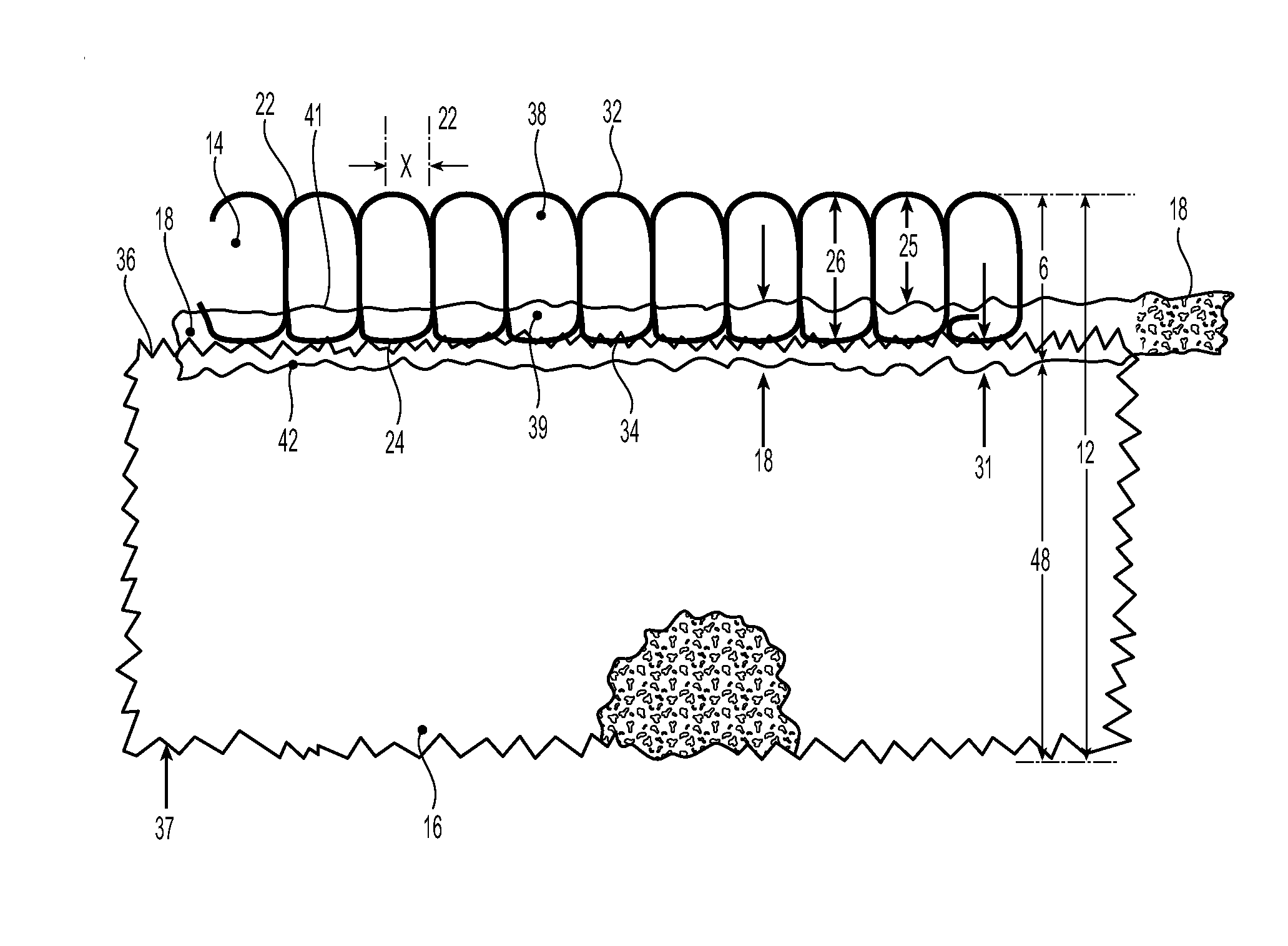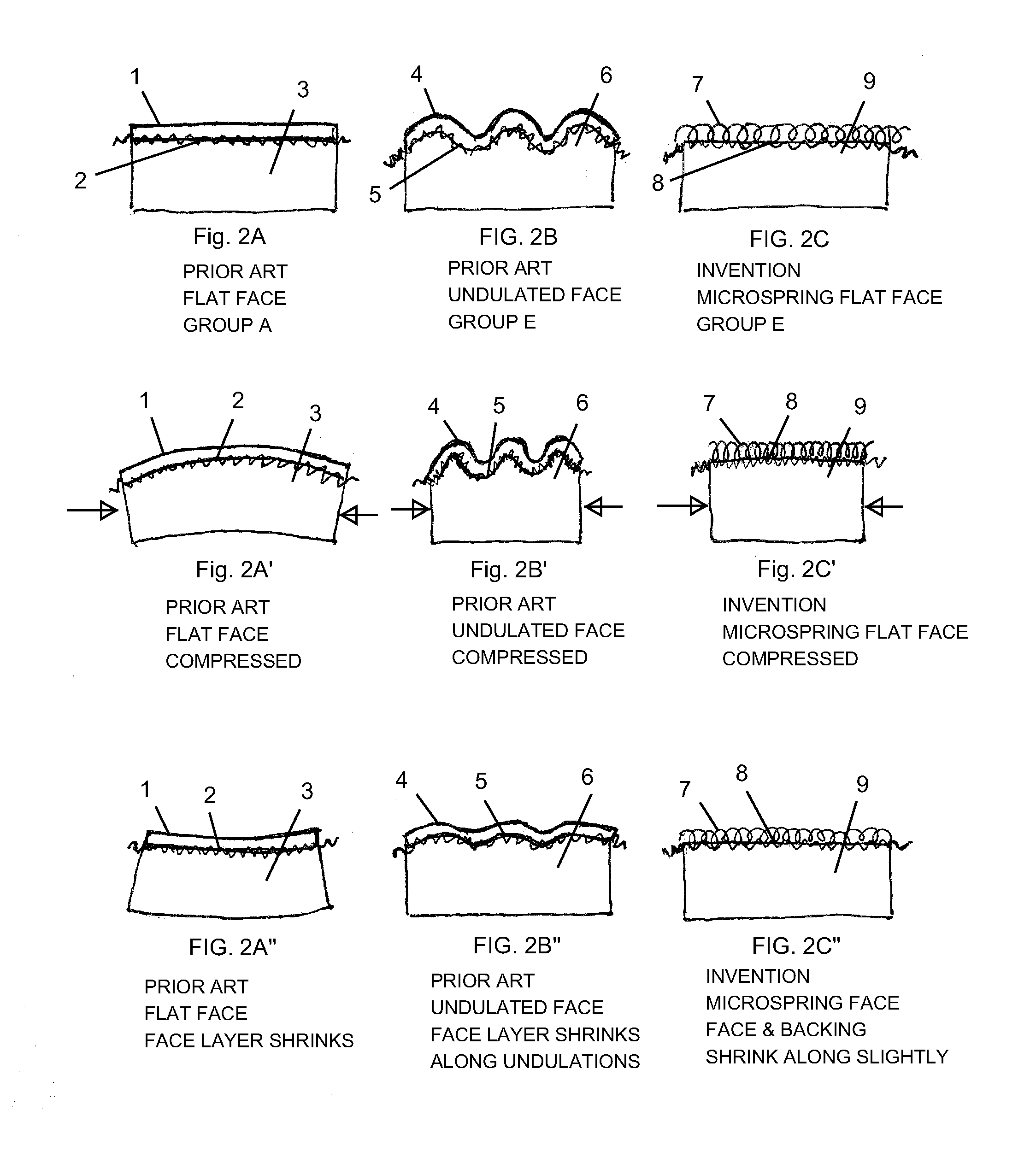Fabric-Faced Floor Coverings with Micro-Spring Face Structures
a technology of face structure and fabric, applied in the field of fabric face laminates, can solve the problems of composites tending to deform out of plane, lack of textile look, softness or sound dampening qualities of textile products, general lack of superior stability of solids, etc., and achieves the effect of low face layer stretch for facial stability, high gathering ability to lay flat, and small scal
- Summary
- Abstract
- Description
- Claims
- Application Information
AI Technical Summary
Benefits of technology
Problems solved by technology
Method used
Image
Examples
example 1
Weft-Knit Staple-Yarn Face Fabric, Group E (See FIG. 4A)
[0136]A weft-knit 1.6 mm thick white commercial weft-knit bulked ladies shirt fabric of spun cotton yarns, weighing 9.2 oz / yd2 (312 g / m2) of the type diagrammatically illustrated in FIG. 4A, was used as fabric face layer 14. Cross-sectional enlargements of the fabric showed a looped yarn structure reciprocating between the two surfaces, with a frequency of about 32 / inch (13 / cm) in the longitudinal direction, and 40 / inch (16 / cm) in the transverse direction. Dimensions L, C and X were calculated from these values to be approximately 0.8, 0.6 and 1.0 mm, as listed in Table I. The fabric was soft, but highly unstable, highly stretchable, and very easy to abrade.
[0137]The fabric was combined with a 0.15 mm thick low density black polyethylene film weighing approximately 145 g / m2 placed over a felted fibrous nonwoven cushioning backing containing 65% polyester fibers and 35% polypropylene fibers, weighing 650 m2, and approximately 6 ...
example 2
Lightweight Warp-Knit Face Fabric, Underlaps Up, Group E (See FIG. 5A)
[0145]A warp-knit polyester fabric was prepared on a 28-gauge knitting machine using a single bar stitching 1-0 / 1-2 at 20 CPI with 150 denier / 34 filament textured nylon feeding two ends per guide. The knit weight was approximately 4.8 oz / yd2, or 163 g / m2. The product gathered automatically in the cross-direction by approximately 25% from 60 inches to 45 inches as it was wound up, while there was a small change in length, with the gage changing to approximately 40 / inch and the CPI to 22 / inch to a density of approximately 880 loops / sq inch or 146 / sq cm. For this configuration, with the underlaps up, dimensions C, L and X were calculated to be approximately 1.1, 0.6 and 0.6 mm. The gathered fabric had a thickness 26 of 1.6 mm, and weighed approximately 6.3 oz / yd2 or 210 g / m2. The fabric was easily stretchable and dimensionally unstable, and had very low resistance to abrasion.
[0146]After lamination under the same pro...
example 3
Lightweight Warp Knit with Underlaps Down, Group E (FIG. 5D)
[0147]The fabric of Example 2 was inverted during lamination with the overlaps down. As shown in Table I adhesive penetrated deeper into the fabric, porosity was redistributed and conformability improved. Durability also marginally improved to 2.5
PUM
| Property | Measurement | Unit |
|---|---|---|
| Fraction | aaaaa | aaaaa |
| Fraction | aaaaa | aaaaa |
| Fraction | aaaaa | aaaaa |
Abstract
Description
Claims
Application Information
 Login to View More
Login to View More - R&D
- Intellectual Property
- Life Sciences
- Materials
- Tech Scout
- Unparalleled Data Quality
- Higher Quality Content
- 60% Fewer Hallucinations
Browse by: Latest US Patents, China's latest patents, Technical Efficacy Thesaurus, Application Domain, Technology Topic, Popular Technical Reports.
© 2025 PatSnap. All rights reserved.Legal|Privacy policy|Modern Slavery Act Transparency Statement|Sitemap|About US| Contact US: help@patsnap.com



